
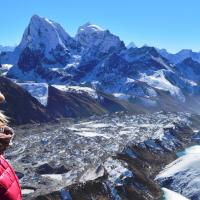

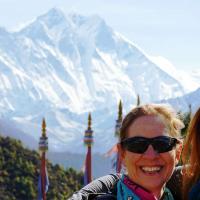
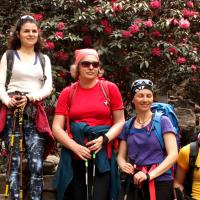
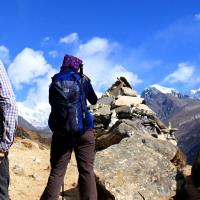
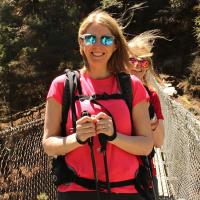
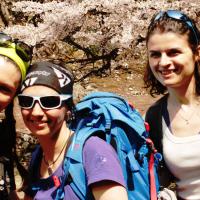
The Everest Base Camp Heli Trek offers a luxurious and time-efficient option for those looking to experience Everest Base Camp but are short on time. Unlike the traditional route, which requires retracing your steps unless you opt for the more challenging trek through Cho La Pass and Gokyo Valley, this deluxe version allows you to fly directly to Lukla, trek to the Base Camp, and then soar back to Kathmandu by helicopter from Gorakshep.
This compact itinerary is meticulously designed to maximize both your time and experience. You'll spend two vital days acclimatizing, ensuring your safety and comfort as you ascend. The trek navigates through quaint Sherpa villages, presenting breathtaking Himalayan landscapes and offering a deep dive into the local culture and natural beauty.
Finally, after reaching Everest Base Camp and Kalapatthar, you'll conclude your adventure with a spectacular helicopter ride back to Kathmandu. This scenic flight offers a unique perspective of the mountains and a soothing end to an exhilarating trek, all within a fraction of the time it takes to complete the traditional route.
Upon your arrival in Nepal, please proceed through customs and visa processing at Kathmandu Airport (TIA). Our office representative will be there to greet you and facilitate your transfer to your pre-selected hotel, assisting you with check-in. Once settled, you have the remainder of the day at your leisure. Feel free to explore the vibrant streets of Thamel or take some time to relax. This is also an excellent opportunity to review your packing list and purchase or rent any additional items you may need.
Today, we'll catch an early morning flight to Lukla for our trek. A representative from Icicles Adventure will escort you to the airport. For the best views of the Himalayas, try to sit by the left-side window of the small aircraft. Upon arriving in Lukla, our other team members, including the porters, will be waiting to meet us. While they organize the luggage, you can enjoy a cup of tea and take in the surroundings. Our trek to Phakding features gentle ascents and a scenic riverside walk along the hill, crossing a few suspension bridges along the way.
Starting early in the day is advisable to make the most of the ideal morning temperatures, weather, and views. As we set out, the majestic Mt. Thamserku greets us from the north, offering a stunning backdrop. The journey continues as we enter Sagarmatha National Park, where our trekking permits are checked at the gate beside a large mani stone. From here, the path descends to the level of the Dudh Koshi River.
The trail then leads us to a challenging uphill climb, crossing the iconic Hillary Suspension Bridge. Soon after, we arrive at Namche Bazaar, where, weather permitting, we may catch our first glimpse of Mt. Everest shortly after the bridge. We will spend the night in one of Namche Bazaar’s quality lodges, resting and preparing for the days ahead.
Today marks our first acclimatization day in the high-altitude region. Staying active is crucial for better acclimatization, so we will hike up to the Everest View Hotel. This not only aids in acclimatizing our bodies but also offers a chance to enjoy breathtaking views of the Himalayas. After this, you can choose to return to your lodge for some rest, or continue exploring. Options include a visit to Khumjung Monastery, which houses the famed Yeti Scalp, and the Hillary School. Another worthwhile stop is the Tourist Visitor Center near the headquarters of Sagarmatha National Park, where you can learn about the first Everest ascenders, Sherpa culture, and the region's flora and fauna. For those seeking further exploration, the nearby villages of Thame and Khunde offer beautiful walks with spectacular views of the snow-capped Himalayas and rich cultural experiences.
The trail contours around the valley side high above Dudhkoshi River. As we trek ahead we get amazingly beautiful views of great peaks of Everest region that are Lhotse, Nuptse and Ama Dablam. We pass through several small villages and tea shops. Its mostly gradual and downhill through refreshing rhododendron forest until Phunki Thenka. We cross suspension bridge and have lunch at Phunki Thenka . After our break we will make the long climb on a dusty zig zag trail. The hike now to Tengboche is uphill through pine trees for about two hours. Tengbouche is home of an ancient monastery that is now rebuilt. The views from the monastery is awesome, we have plenty of time to have spiritual chat with the monks there and soak up in the view too.
Before giving your baggage to porters and starting the trek, remember to pack your windproof jacket with you on your backpack today; you will need it (even in the warm season, and if it is colder, like December-February, you will need a down jacket almost throughout the trek). Today's first part of the walk is a slight descent through pine and Himalayan cherry trees. Then, we cross the wooden bridge over the Imja River. After crossing the Imja River, it slightly ascends to Pangboche village. We have our lunch at Somare Village, enjoying the views. View the beauty of Mt. Everest, as we will not see it shortly for two more days until you reach Gorekshep. As we have significantly gained altitude, we notice more small shrubs that now substitute the shady trees. We see an unpleasant rocky landscape as no noticeable plants cover the landscape except grass in the meadows (post-monsoon time). Now it's time to take out your windproof jacket and probably headband to avoid a strong blast of air. If exposed to the chilly wind, you will be prone to the common sickness here—the Khumbu cough, so take preventive methods.
Dingboche is the perfect altitude to spend our second acclimatization day. We stay active throughout the day; thus, we hike to a higher altitude to Nangkartshang Peak (5083 m/16676 ft ), north of Dingboche. Or, if you want to take a challenging, more extended day, you might go climbing Chhukung Ri, which offers up-close views of Mt. Ama Dablam, Island Peak, Mt. Makalu, Mt. Lhotse, Mt. Thamserku, Awi peak and innumerable others. We also get a glance at Pheriche Valley from the top. However, the stone huts with snow-capped Himalayas as a backdrop would make anyone spellbound.
We have been gaining significant altitude, so it is normal to gasp, lack energy, have a headache, lose appetite, and sometimes feel nauseated. Don’t hesitate to share these experiences with your guide if you get severe symptoms and how you are feeling every while and again. However, the awful feeling the altitude gives you will be conquered by the outstanding vistas of Lobuche East (6,119m/ 20,075ft) ahead and the formidable north face of Tabuche to the left. Finally, we reach Dugla (4,620m/15,153ft) after three hours.
After lunch, we will continue the walk up the steep hill to the Sherpa memorials. Again, there are outstanding views of Ama Dablam, Cholatse, and Tabuche. From Dugla, the trail starts steeply towards the glacier moraine and levels out. After a few hours, the trail eventually leads to a small cluster of tea houses pleasantly situated at Lobuche (4,940m/16,207ft). We feel excited that the Everest base camp lies 1,000 ft above this point.
Get up early to start our long walking day. Our grueling hiking day begins with an ascend to Lobuche Pass. Then, slowly walking through a dangerous rocky path, in about three hours, we arrive at Gorakshep. We check in to our guest house, get our lunch done and start the hike to Everest Base Camp. The trail reaches the top of the ridge and follows the mountain’s spine due north towards the cul-de-sac at the glacier’s end. The elevation makes the hike exhausting, but the views make it worth taking the tour. From EBC, the Khumbu glacier and views of Pumori, Nuptse, and Khumbutse are seen. Views of Everest are, however, best seen from Kalapatthar tomorrow morning.
Another option today is to hike Kalapatthar in the late afternoon to get the best views of Mt. Everest at sunset and target Everest base camp tomorrow morning. If we do this, we will hike up steep in sunlight and return in dusk. You can discuss or plan your interest and suggestion from our professional trekking guide at the final moment too. Anyway, we trek back to Gorekshep to spend the night.
We are taking a hike to Kalapatthar today. About a two to three hours hike is grueling but take it slowly and thoroughly to enjoy the view. You are sure to realize that you have done the most worthy thing upon reaching the top of Kalapatthar gives the most stunning view of Mt. Everest, Lhotse, Pumori, Nuptse, Ama Dablam, and the whole Mahalangur Himalayan range is superb from Kalapatthar. The breathtaking view of Everest Base Camp, the massive Khumbu Glacier, and the 360-degree view are spectacular. While you take photographs, your helicopter will be there, and you will take an enjoyable Heli ride back to Kathmandu. So don’t miss to watch out for the Himalayan vistas from the helicopter too; it is a fantastic opportunity.
If you don't have other schedules fixed in Nepal, you might be leaving today. We will provide an airport drop for your scheduled flight back home and wish you a safe flight. We are sure the Everest Base Camp Heli trek has left you determined to come to Nepal again to explore its more beautiful landscapes in the future.
These are standard group departures for Everest Base Camp Heli Trek trip. We understand these departures may not suit your schedules, if so, please feel free to ask a customized departure date that suits you. Also, if you are looking for a different customized itinerary, please ask our local travel specialist for a new personalized, customized program as per your interests and requirements.
| Trip Start Date | Trip End Date | Seat Left | Price (USD) | Status | |
|---|---|---|---|---|---|
|
Thursday
18-Sep, 2025 |
Sunday
28-Sep, 2025 |
- | USD 0 | Book Now |
Registered with: Company Registration Office, Government of Nepal
Licensed by: Nepal Tourism Board & Department of Tourism
Proud Member of Trekking Agency's Association of Nepal
General Member of Nepal Mountaineering Association
Life Member of Kathmandu Environmental Education Project